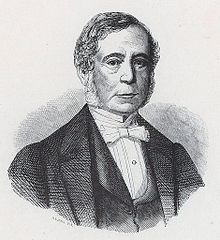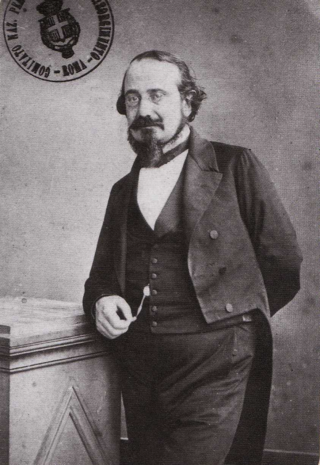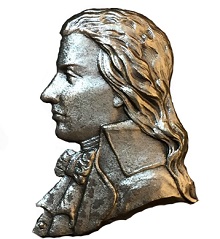
Saverio Baldacchini (born Francesco Saverio Baldacchini Gargano; 24 April 1800, Barletta - 13 March 1879, Naples) was an Italian politician, writer and poet.

Saverio Baldacchini (born Francesco Saverio Baldacchini Gargano; 24 April 1800, Barletta - 13 March 1879, Naples) was an Italian politician, writer and poet.
Born into an aristocratic family originating in Amantea, [1] he was the son of Giuseppe Baldacchini and Giovanna Vecchioni. His father died when he and his brother Michele were still very young and so the family moved to Naples, where he studied under the historian Carlo Troya, published political essays whilst still a student and finally ended up in exile after the failure of the 1820-1821 Revolution. He travelled extensively in Italy, Paris and Britain, reaching as far as London and becoming friends with politicians and intellectuals such as Carlo and Alessandro Poerio. He also took part in the debate between classicism and romanticism. [2]
He returned to Italy in 1837, where he backed Basilio Puoti's moves for purism in Italian literature. He wrote an essay in Puoti's honour, in which he sought to refute accusations of pedantry against Puoti, perhaps arising from a misunderstanding of Ultimo dei puristi by Francesco De Sanctis. [3] In 1840 Baldacchini married the widowed mother of Ruggero Bonghi, who was greatly influenced by his new step-father. He became more and more involved in moderate liberal politics, founding several daily newspapers and in 1848 becoming a deputy to the Neapolitan Parliament for the college of Bari. There he headed a movement to put the constitution into immediate effect and became president of the Commission for Public Education. After Ferdinand II's coup and the replacement of Carlo Troya's government with that of Gennaro Spinelli di Cariati on 15 May 1848, Baldacchini left politics to devote himself to writing.
After Italian unification he returned to politics, taking an active interest in reforming the school system of the former Kingdom of the Two Sicilies and strengthening Naples University and the Accademia Pontaniana. He was elected as a deputy in the Kingdom of Italy's parliament for the Barletta college and was President of the Chamber's Library Commission from 1863 to 1865, but he was defeated by Pasquale Petrone in the repeat of the cancelled 1865 elections. His nomination as a senator in 1868 was not confirmed [4] and a few days later had a stroke, leaving him paralysed for the rest of his life.
Purist and classicist, Baldacchini was sensitive to romantic influences in art literature, and after the release of the poem Ugo da Cortona (1839) he found himself at the center of the classic-romantic controversies, as for some he was romantic, for others an exemplary classicist. Come sintetizzò Guido Mazzoni, Saverio Baldacchini «romanticheggiò classicamente». He also wrote a novel in verse Claudio Vannini or The Artist (1835),

Saverio Bettinelli was an Italian Jesuit writer. He became known as a polymath, dramatist, polemicist, poet, and literary critic. He was a friend of some of the leading authors of his times: Voltaire, Francesco Algarotti, Vincenzo Monti and Ippolito Pindemonte. Théodore Tronchin, Guillaume du Tillot, Melchiorre Cesarotti, Giacomo Filippo Durazzo, Pietro Verri, Giammaria Mazzucchelli and Francesco Maria Zanotti were among his correspondents.

Francesco de Sanctis was an Italian literary critic, scholar and politician, leading critic and historian of Italian language and literature during the 19th century.

Giuseppe Saverio Poli was an Italian physicist, biologist and natural historian.

The Diocese of Altamura-Gravina-Acquaviva delle Fonti is a Latin Church diocese of the Catholic Church in Apulia, southern Italy, 40 km south-west of the coastal city of Bari. In 1986. the territorial prelature of Altamura e Acquaviva delle Fonti was united with the diocese of Gravina. The present diocese is a suffragan of the archdiocese of Bari-Bitonto.

Girolamo Graziani was an Italian poet and diplomat.
Luigi Mosca was Italian composer of operas and sacred music and a noted singing teacher. He composed eighteen operas, most of which were originally for theatres in Naples, but played throughout Italy in their day.

Carlo Troya was a historian and politician who served as Prime Minister of the Two Sicilies from 3 April 1848 until 15 May 1848. Politically, he was a liberal Neo-Guelph who supported Italian unification. His primary historical interest was the study of the Early Middle Ages, to which he made lasting contributions.

Bertrando Spaventa was a leading Italian philosopher of the 19th century whose ideas had an important influence on the changes that took place during the unification of Italy and on philosophical thought in the 20th century.

San Giacomo degli Italiani is a church located on Via Depretis in Naples, Italy.

Santa Maria del Parto a Mergellina is a church located in the quartiere of Chiaia in Naples, Italy. The church is peculiarly perched on top of a private building and accessed by a stairway, placed behind a restaurant located in piazza Mergellina.
Michele Troja or Michele Troya was an Italian physician.
The following is a timeline of the history of the city of Bari in the Apulia region of Italy.
Annibale Ruccello was an Italian playwright, theatre director, and actor.

Basilio Puoti was an Italian literary critic, lexicographer and grammarian.

Luca de Samuele Cagnazzi was an Italian archdeacon, scientist, mathematician, political economist. He also wrote a book about pedagogy and invented the tonograph.

Ottavio Serena was an Italian politician, judge, prefect and historian. He is known in his hometown Altamura for his works about local history, such as the Altamuran Revolution (1799). His contribution and the testimonies he collected allowed to shed light on some historical events (such as the killing of Giovanni Firrao and on legendary toponyms.

Ernesto Capocci Belmonte was an Italian mathematician, astronomer and politician.

Luigi Capotorti was an Italian composer of both sacred and secular music. He was the maestro di cappella of several Neapolitan churches; the composer of ten operas, five of which premiered at the Teatro San Carlo in Naples; and a teacher of composition and singing whose students included Stefano Pavesi and Saverio Mercadante. Born in Molfetta, he studied violin and composition at the Conservatorio di Sant'Onofrio in Naples and spent his entire career in that city. In his later years, Capotorti retired to San Severo, where he died at the age of 75.

Giuseppe, Antonio Pietro Cassella was an Italian astronomer, professor of Astronomy at the Naples University and first director of the Astronomical Observatory of Naples.

Mariano d'Ayala was a Sicilian-born soldier, writer and, after 1848, an activist-politician and member of parliament.